%%html
<script src="https://bits.csb.pitt.edu/preamble.js"></script>
Recap¶
- Models: Classification vs. Regression
- Evaluation of model predictions
- Regression: mean squared error, root mean squared error, absolute error, correlation
- Classification: accuracy, F1 (precision+recall), AUC
- Evaluation of models
- Cross-validation
What is 'good'?¶
- compare to previous work
- compare to trivial baseline
- compare to simple baseline
from sklearn.linear_model import LogisticRegression
import pandas as pd
data = pd.read_csv('bcsmall.csv')
features = data.drop(['age','alive'],axis='columns')
genes = data.columns[2:]
You are developing a very cheap machine learning powered at-home test for a rare condition. If the test reports a positive value (the user has the condition), a more expensive, but still non-invasive, test can be run to verify the diagnosis. If the test erroneously reports a negative result, the user will die a horrible and painful preventable death.
%%html
<div id="evalq" style="width: 500px"></div>
<script>
$('head').append('<link rel="stylesheet" href="https://bits.csb.pitt.edu/asker.js/themes/asker.default.css" />');
var divid = '#evalq';
jQuery(divid).asker({
id: divid,
question: "Which metric are you probably most concerned with?",
answers: ["Recall","Precision","Accuracy","F1","Liability"],
server: "https://bits.csb.pitt.edu/asker.js/example/asker.cgi",
charter: chartmaker})
$(".jp-InputArea .o:contains(html)").closest('.jp-InputArea').hide();
</script>
Generalized F1¶
$$F_\beta = (1+\beta^2)\frac{\mathrm{precision}\cdot\mathrm{recall}}{(\beta^2\cdot\mathrm{precision})+\mathrm{recall}}$$
Bias towards recall: $$F_2 = \frac{5\cdot\mathrm{precision}\cdot\mathrm{recall}}{(4\cdot\mathrm{precision})+\mathrm{recall}}$$ Bias towards precision: $$F_{0.5} = \frac{1.25\cdot\mathrm{precision}\cdot\mathrm{recall}}{(.25\cdot\mathrm{precision})+\mathrm{recall}}$$
Reminder: AUC of ROC¶
from sklearn.metrics import *
logistic_regression = LogisticRegression()
logistic_regression.fit(features,data.alive)
prob = logistic_regression.predict_proba(features)[:,1]
predicts = logistic_regression.predict(features)
print("AUC of probabilities: %f"%roc_auc_score(data.alive,prob))
print("AUC of predictions: %f"%roc_auc_score(data.alive,predicts))
AUC of probabilities: 0.983674 AUC of predictions: 0.688235
Why different?¶
fpr,tpr,_ = roc_curve(data.alive,prob)
pfpr,ptpr,_ = roc_curve(data.alive,predicts)
plt.plot(fpr,tpr,label='predict_proba')
plt.plot(pfpr,ptpr,label='predict')
plt.gca().set_aspect('equal');plt.legend();plt.xlabel('FPR');plt.ylabel('TPR');
predicts
array([1, 1, 1, 1, 1, 1, 1, 1, 1, 1, 1, 1, 1, 1, 0, 1, 1, 1, 1, 1, 1, 1,
1, 1, 0, 1, 1, 1, 1, 1, 1, 1, 1, 1, 1, 1, 1, 1, 1, 1, 1, 1, 1, 1,
1, 1, 1, 1, 1, 1, 1, 1, 1, 0, 1, 1, 1, 1, 1, 1, 1, 1, 1, 1, 1, 1,
1, 1, 1, 1, 1, 1, 1, 1, 1, 1, 1, 1, 1, 1, 1, 1, 1, 1, 1, 1, 1, 1,
1, 1, 1, 1, 1, 1, 1, 1, 1, 1, 1, 1, 1, 1, 1, 1, 1, 1, 1, 1, 1, 1,
1, 1, 1, 1, 1, 0, 0, 1, 1, 1, 1, 1, 1, 1, 1, 1, 1, 1, 1, 1, 1, 1,
1, 1, 1, 1, 1, 1, 1, 1, 1, 1, 1, 1, 1, 1, 1, 1, 1, 1, 0, 1, 1, 1,
1, 1, 1, 1, 1, 1, 1, 1, 1, 1, 1, 1, 1, 1, 1, 1, 1, 1, 1, 1, 1, 1,
1, 1, 1, 1, 1, 1, 1, 1, 1, 1, 1, 1, 1, 1, 1, 1, 1, 1, 1, 1, 1, 1,
1, 1, 1, 1, 1, 1, 1, 1, 1, 1, 1, 1, 1, 1, 1, 1, 1, 1, 1, 1, 1, 1,
1, 1, 1, 1, 1, 1, 1, 1, 1, 1, 1, 1, 1, 1, 1, 1, 1, 0, 1, 1, 1, 1,
1, 1, 1, 1, 1, 1, 1, 1, 1, 1, 1, 1, 1, 1, 1, 1, 1, 1, 1, 1, 1, 1,
1, 1, 1, 1, 1, 1, 1, 1, 1, 1, 1, 1, 1, 1, 1, 1, 1, 1, 1, 1, 1, 1,
0, 1, 1, 0, 1, 1, 1, 1, 1, 1, 1, 1, 1, 1, 1, 1, 1, 1, 1, 1, 1, 1,
1, 1, 1, 1, 1, 1, 1, 1, 1, 1, 1, 1, 1, 1, 1, 1, 1, 1, 1, 1, 0, 1,
1, 0, 0, 0, 1, 0, 1, 1, 1, 0, 1, 0, 1, 1, 1, 1, 1, 1, 1, 1, 1, 1,
1, 1, 1, 1, 1, 1, 1, 1, 1, 1, 1, 1, 1, 1, 1, 1, 1, 1, 1, 1, 1, 1,
1, 1, 1, 1, 1, 1, 1, 1, 1, 1, 1, 1, 1, 1, 1, 1, 1, 1, 1, 1, 1, 1,
1, 1, 1, 1, 1, 1, 1, 1, 1, 1, 1, 1, 1, 1, 1, 1, 1, 1, 1, 1, 1, 1,
1, 1, 1, 1, 1, 1, 1, 1, 1, 1, 1, 1, 1, 1, 1, 1, 1, 1, 1, 1, 1, 1,
1, 1, 1, 1, 1, 1, 1, 1, 1, 1, 1, 1, 1, 1, 1, 1, 1, 1, 1, 1, 1, 1,
1, 1, 1, 1, 1, 1, 1, 0, 0, 0, 1, 1, 0, 0, 0, 1, 1, 1, 1, 0, 1, 1,
0, 1, 1, 1, 0, 0, 1, 0, 1, 1, 1, 1, 1, 1, 0, 1, 0, 1, 1, 1, 1, 0,
1, 1, 1, 1, 1, 1, 1, 1, 1, 1, 1, 1, 1, 1, 1, 1, 1, 1, 1, 1, 1, 1,
1, 1, 1, 1, 1, 1, 1, 1, 1, 1, 1, 1, 1, 1, 1, 1, 1, 1, 1, 1, 1, 1,
1, 1, 1, 1, 1, 1, 1, 1, 1, 1, 1, 1, 1, 1, 1, 1, 1, 1, 1, 1, 1, 1,
1, 1, 1, 1, 1, 1, 1, 1, 1, 1, 1, 1, 1, 1, 1, 1, 1, 1, 1, 1, 1, 1,
1, 1, 1, 1, 1, 1, 1, 1, 1, 1, 1, 1, 1, 1, 1, 1, 1, 1, 1, 1, 1, 1,
1, 1, 1, 1, 1, 1, 1, 1, 1, 1, 1, 1, 1, 1, 1, 1, 1, 1, 1, 1, 1, 1,
1, 1, 1, 1, 1, 1, 1, 1, 1, 1, 1, 1, 1, 1, 1, 1, 1, 1, 1, 1, 1, 1,
1, 1, 1, 1, 1, 1, 1, 1, 1, 1, 1, 1, 1, 1, 1, 1, 1, 1, 1, 1, 1, 1,
1, 1, 1, 1, 1, 1, 1, 0, 1, 1, 1, 1, 1, 1, 1, 1, 1, 1, 1, 1, 1, 1,
1, 1, 1, 1, 1, 1, 1, 1, 1, 1, 1, 1, 1, 1, 1, 1, 1, 1, 1, 1, 1, 1,
1, 1, 1, 1, 1, 1, 1, 1, 1, 1, 1, 1, 1, 1, 1, 1, 1, 1, 1, 1, 1, 1,
1, 1, 1, 1, 1, 1, 0, 1, 1, 1, 1, 1, 1, 1])
fig
%%html
<div id="aucstairs" style="width: 500px"></div>
<script>
$('head').append('<link rel="stylesheet" href="https://bits.csb.pitt.edu/asker.js/themes/asker.default.css" />');
var divid = '#aucstairs';
jQuery(divid).asker({
id: divid,
question: "Which does the stair shape mean?",
answers: ["The test set is small","Many identical predictions","Winning/losing streaks","All the above","Some of the above"],
server: "https://bits.csb.pitt.edu/asker.js/example/asker.cgi",
charter: chartmaker})
$(".jp-InputArea .o:contains(html)").closest('.jp-InputArea').hide();
</script>
Reminder: Cross Validation¶
In cross validation we train on a portion of the data and test on the remainder.
K-Fold Cross Validation¶
- split data into k non-overlapping parts, or folds
- train k models, each using a different set of k-1 folds
- evaluate on held out set
If k == n, called leave-one-out cross validation.

%%html
<div id="booty" style="width: 500px"></div>
<script>
$('head').append('<link rel="stylesheet" href="https://bits.csb.pitt.edu/asker.js/themes/asker.default.css" />');
var divid = '#booty';
jQuery(divid).asker({
id: divid,
question: "Which kind of cross validation constructs training sets by sampling with replacment?",
answers: ["Clustered","Stratified","Oversampling","Bootstrapping","Out-of-bag"],
server: "https://bits.csb.pitt.edu/asker.js/example/asker.cgi",
charter: chartmaker})
$(".jp-InputArea .o:contains(html)").closest('.jp-InputArea').hide();
</script>
Vocab¶
- Training Data Data used to fit a model.
- Validation Data Data used to evaluate a model and optimize model (hyper) parameters
- (Independent) Test Data Data used once to evaluate final model.

Regularization¶
Lasso is a modified form of linear regression that includes an L1 regularization parameter $\alpha$ $$\sum(Xw - y)^2 + \alpha\sum|w|$$
Ridge regression includeds an L2 regularization parameter. $$\sum(Xw - y)^2 + \alpha\sum|w|^2$$
Elastic net includes both $$\sum(Xw - y)^2 + \alpha \rho \sum|w| + \alpha (1-\rho) \sum|w|^2$$
Lasso: $\rho = 1$
Ridge: $\rho = 0$
The higher the value of $\alpha$, the greater the penalty for having non-zero weights. This has the effect of driving weights to zero and selecting fewer features for the model.
Model Parameter Optimization¶
Most classifiers have parameters, like $\alpha$ in Lasso, that can be set to change the classification behavior. These are hyperparameters - they are parameters that control the learning process, not parameters that are learned during training.
A key part of training a model is figuring out what hyperparameters to use.
This is typically done by a brute-force grid search (i.e., try a bunch of values and see which ones work)
logistic_regression_model = LogisticRegression()
logistic_regression_model.get_params()
{'C': 1.0,
'class_weight': None,
'dual': False,
'fit_intercept': True,
'intercept_scaling': 1,
'l1_ratio': None,
'max_iter': 100,
'multi_class': 'auto',
'n_jobs': None,
'penalty': 'l2',
'random_state': None,
'solver': 'lbfgs',
'tol': 0.0001,
'verbose': 0,
'warm_start': False}
Loss (cost) functions¶
Note that for this notation $y \in \{0,1\}$
Recall: $$\hat{p}(X_i) = \frac{1}{1 + e^{(-X_i w - w_0)}}$$
L2 regularized logistic regression: $$\min_{w} \frac{1}{2}w^T w + C \sum_{i=1}^n \left(-y_i \log(\hat{p}(X_i)) - (1 - y_i) \log(1 - \hat{p}(X_i))\right) $$
L1 regularized logistic regression: $$\min_{w} \|w\|_1 + C \sum_{i=1}^n \left(-y_i \log(\hat{p}(X_i)) - (1 - y_i) \log(1 - \hat{p}(X_i))\right) $$
Model Parameter Optimization¶
- Grid search. Systematically explore hyper parameter space. Highly parallel.
- Random search. Randomly explore hyper parameter space. Highly parallel. In practice usually outperforms grid search.
- Bayesian optimization. Intelligently explore hyper parameter space. Less parallel.
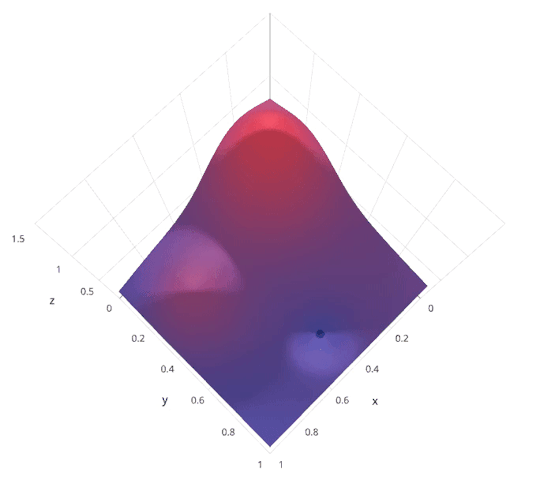 |
 |
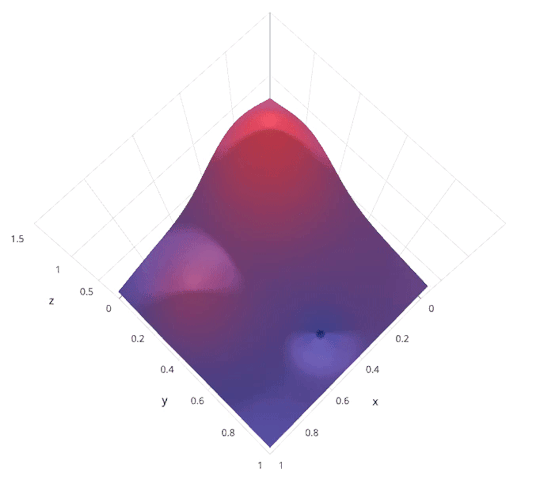 |
http://blog.sigopt.com/post/144221180573/evaluating-hyperparameter-optimization-strategies
from sklearn.model_selection import GridSearchCV
param_grid = [
{'C': [0.01,0.1,1.0,10,100], #regularization strength, smaller means stronger regularization
'penalty': ['l1','l2'],
'solver': ['liblinear']}
]
grid_search = GridSearchCV(logistic_regression_model, param_grid,scoring='roc_auc',return_train_score=True)
grid_search.fit(features,data.alive)
results = pd.DataFrame(grid_search.cv_results_)
results
| mean_fit_time | std_fit_time | mean_score_time | std_score_time | param_C | param_penalty | param_solver | params | split0_test_score | split1_test_score | ... | mean_test_score | std_test_score | rank_test_score | split0_train_score | split1_train_score | split2_train_score | split3_train_score | split4_train_score | mean_train_score | std_train_score | |
|---|---|---|---|---|---|---|---|---|---|---|---|---|---|---|---|---|---|---|---|---|---|
| 0 | 0.025610 | 0.005470 | 0.012169 | 0.000768 | 0.01 | l1 | liblinear | {'C': 0.01, 'penalty': 'l1', 'solver': 'liblin... | 0.500000 | 0.500000 | ... | 0.500000 | 0.000000 | 9 | 0.500000 | 0.500000 | 0.500000 | 0.500000 | 0.500000 | 0.500000 | 0.000000 |
| 1 | 0.021763 | 0.000103 | 0.011302 | 0.000385 | 0.01 | l2 | liblinear | {'C': 0.01, 'penalty': 'l2', 'solver': 'liblin... | 0.351644 | 0.493945 | ... | 0.513780 | 0.115224 | 8 | 0.651313 | 0.622390 | 0.614852 | 0.587096 | 0.633180 | 0.621766 | 0.021230 |
| 2 | 0.021397 | 0.000182 | 0.012072 | 0.000557 | 0.1 | l1 | liblinear | {'C': 0.1, 'penalty': 'l1', 'solver': 'libline... | 0.492647 | 0.500000 | ... | 0.498529 | 0.002941 | 10 | 0.556989 | 0.500000 | 0.500000 | 0.500000 | 0.500000 | 0.511398 | 0.022795 |
| 3 | 0.022877 | 0.000778 | 0.013038 | 0.002132 | 0.1 | l2 | liblinear | {'C': 0.1, 'penalty': 'l2', 'solver': 'libline... | 0.398789 | 0.581315 | ... | 0.541990 | 0.090484 | 4 | 0.910718 | 0.920531 | 0.921207 | 0.942614 | 0.924693 | 0.923953 | 0.010423 |
| 4 | 0.022410 | 0.000151 | 0.012311 | 0.000899 | 1.0 | l1 | liblinear | {'C': 1.0, 'penalty': 'l1', 'solver': 'libline... | 0.591047 | 0.571367 | ... | 0.517711 | 0.063177 | 7 | 0.869659 | 0.886988 | 0.875190 | 0.903177 | 0.901793 | 0.887361 | 0.013565 |
| 5 | 0.023331 | 0.000264 | 0.011583 | 0.000285 | 1.0 | l2 | liblinear | {'C': 1.0, 'penalty': 'l2', 'solver': 'libline... | 0.442907 | 0.601211 | ... | 0.545904 | 0.061375 | 2 | 0.991913 | 0.990771 | 0.986488 | 0.993678 | 0.984250 | 0.989420 | 0.003507 |
| 6 | 0.025823 | 0.000899 | 0.011762 | 0.000065 | 10 | l1 | liblinear | {'C': 10, 'penalty': 'l1', 'solver': 'liblinear'} | 0.483997 | 0.575260 | ... | 0.545795 | 0.040221 | 3 | 0.998519 | 0.997037 | 0.996920 | 0.999240 | 0.996676 | 0.997679 | 0.001013 |
| 7 | 0.025896 | 0.000688 | 0.012265 | 0.000860 | 10 | l2 | liblinear | {'C': 10, 'penalty': 'l2', 'solver': 'liblinear'} | 0.439014 | 0.589100 | ... | 0.552900 | 0.067465 | 1 | 0.997866 | 0.996561 | 0.994709 | 0.999159 | 0.997110 | 0.997081 | 0.001472 |
| 8 | 0.028389 | 0.001174 | 0.011824 | 0.000429 | 100 | l1 | liblinear | {'C': 100, 'penalty': 'l1', 'solver': 'libline... | 0.405709 | 0.578287 | ... | 0.522072 | 0.060031 | 6 | 0.999932 | 0.999850 | 0.999864 | 0.999973 | 0.999959 | 0.999916 | 0.000050 |
| 9 | 0.026403 | 0.000829 | 0.011637 | 0.000077 | 100 | l2 | liblinear | {'C': 100, 'penalty': 'l2', 'solver': 'libline... | 0.421713 | 0.573097 | ... | 0.537611 | 0.063413 | 5 | 0.999878 | 0.999823 | 0.999783 | 0.999946 | 0.999607 | 0.999807 | 0.000114 |
10 rows × 23 columns
results = results.apply(pd.to_numeric,errors='ignore')
results.pivot(index="param_C", columns="param_penalty", values="mean_test_score")
| param_penalty | l1 | l2 |
|---|---|---|
| param_C | ||
| 0.01 | 0.500000 | 0.513780 |
| 0.10 | 0.498529 | 0.541990 |
| 1.00 | 0.517711 | 0.545904 |
| 10.00 | 0.545795 | 0.552900 |
| 100.00 | 0.522072 | 0.537611 |
results.pivot(index="param_C", columns="param_penalty",values="mean_train_score")
| param_penalty | l1 | l2 |
|---|---|---|
| param_C | ||
| 0.01 | 0.500000 | 0.621766 |
| 0.10 | 0.511398 | 0.923953 |
| 1.00 | 0.887361 | 0.989420 |
| 10.00 | 0.997679 | 0.997081 |
| 100.00 | 0.999916 | 0.999807 |
Interpretting a Model¶
One advantage of linear models is they are very easy to interpret. Each weight coefficient tells you how important a feature is and which direction it pushes the classification.
from sklearn.linear_model import LogisticRegression
logistic_regression = LogisticRegression(C=10)
logistic_regression.fit(features,data.alive)
logistic_regression.intercept_
array([3.04327491])
sortedweights = sorted(zip(data.columns[2:],logistic_regression.coef_[0]),key=lambda nc: nc[1])
sortedweights[:10]
[('PIK3R1', -2.874088611326588),
('CSMD3', -2.8151218379587393),
('THSD7A', -2.766726935539717),
('CAD', -2.5929974178877524),
('PKD1L1', -2.5796542176332724),
('SDK2', -2.5767565204604916),
('NALCN', -2.453466426627667),
('PXDNL', -2.4230429934666056),
('FAT1', -2.39291299020168),
('ADAMTS12', -2.3833216686867518)]
sortedweights[-10:]
[('ZFHX4', 2.1626666779484407),
('RYR1', 2.198097348283536),
('TLR4', 2.241908338758221),
('GCC2', 2.27350644321561),
('MAP1A', 2.311359601052278),
('HSPG2', 2.4600935594282065),
('SF3B1', 2.4678744338251706),
('HS6ST1', 2.4949960821740724),
('TBC1D4', 2.501116817134397),
('OTOF', 2.575083185135333)]
Feature Engineering vs. Feature Selection¶
- Feature Engineering: how you represent your data (e.g. a molecule can be a binary fingerprint, a graph, a string, a bag of distances, a density grid, a wave function...)
- Feature Selection: Deciding which features to use in your model
Feature Selection¶
Interestingly, even with regularization, none of the logistic regression weights were zero (probably need a larger regularization term and/or use of L1).
import numpy as np
np.count_nonzero(logistic_regression.coef_),logistic_regression.coef_.shape
(497, (1, 497))
plt.hist(logistic_regression.coef_[0],bins=20);
logistic_regression_l1 = LogisticRegression(C=10,penalty='l1',solver='liblinear')
logistic_regression_l1.fit(features,data.alive);
np.count_nonzero(logistic_regression_l1.coef_)
272
plt.hist(logistic_regression_l1.coef_[0],bins=20);
L1 regularization tends to result in sparse solutions
https://explained.ai/regularization/L1vsL2.html
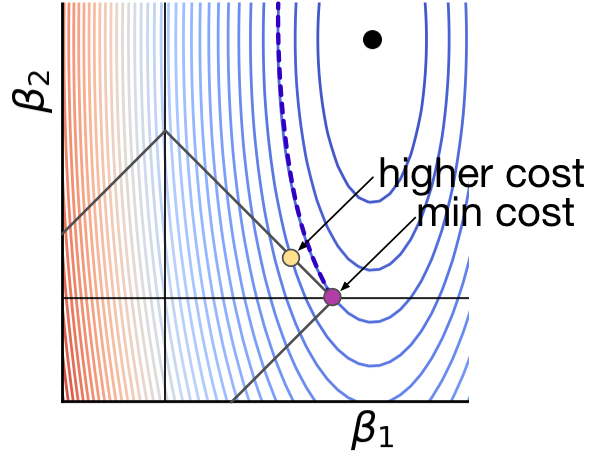 |
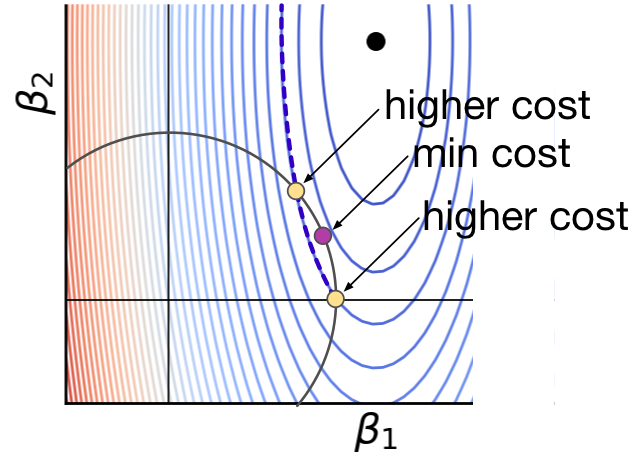 |
Feature Selection¶
Fewer features -> simpler model -> less overfitting -> but also less expressive
- Univariate feature selection
- Model-guided feature selection
- Recursive feature elimination
- Iterative greedy feature selection
- Non-greedy algorithms
Univariate Feature Selection¶
Remove features based on statistical test of single feature.
VarianceThreshold will transform features by selecting only those with variance greater than specified threshold. Can extract the mask (get_support) used to select features and can apply transformation to other identically shaped feature sets.
from sklearn.feature_selection import VarianceThreshold
sel = VarianceThreshold(threshold=.1)
sel_features = sel.fit_transform(features)
genes[sel.get_support()]
Index(['GATA3', 'PIK3CA', 'TP53', 'TTN'], dtype='object')
from sklearn.model_selection import cross_val_score
cross_val_score(logistic_regression,sel_features,data.alive,scoring='roc_auc',cv=5)
array([0.5841263 , 0.59731834, 0.40239651, 0.48366013, 0.57777778])
%%html
<div id="varthresh" style="width: 500px"></div>
<script>
$('head').append('<link rel="stylesheet" href="https://bits.csb.pitt.edu/asker.js/themes/asker.default.css" />');
var divid = '#varthresh';
jQuery(divid).asker({
id: divid,
question: "If all the examples have the same value for a feature, will that feature be selected with this method?",
answers: ["Yes","No"],
server: "https://bits.csb.pitt.edu/asker.js/example/asker.cgi",
charter: chartmaker})
$(".jp-InputArea .o:contains(html)").closest('.jp-InputArea').hide();
</script>
Univariate Feature Selection¶
Can also look at the relationship between individual features and the label.
from sklearn.feature_selection import SelectKBest
from sklearn.feature_selection import chi2
from sklearn.feature_selection import f_classif
from sklearn.feature_selection import mutual_info_classif
sel = SelectKBest(chi2,k=10) # chi-squared statistic
sel_features = sel.fit_transform(features,data.alive)
genes[sel.get_support()]
Index(['ANK3', 'ATRX', 'ERBB3', 'GOLGA6L2', 'ITPR2', 'MLL3', 'NRXN2', 'PIK3R1',
'RYR1', 'THSD7A'],
dtype='object')
sel = SelectKBest(f_classif,k=10) # ANOVA F-value between label/feature (linear dependence)
sel_features = sel.fit_transform(features,data.alive)
genes[sel.get_support()]
Index(['ANK3', 'ATRX', 'ERBB3', 'GOLGA6L2', 'ITPR2', 'MLL3', 'NRXN2', 'PIK3R1',
'RYR1', 'TTN'],
dtype='object')
sel = SelectKBest(mutual_info_classif,k=10) # mutual information, slower but nonlinear
sel_features = sel.fit_transform(features,data.alive)
genes[sel.get_support()]
Index(['C2orf16', 'CNTNAP2', 'DLC1', 'FLG', 'IGSF10', 'KIAA1731', 'PAPPA2',
'PCDH11X', 'RYR3', 'YLPM1'],
dtype='object')
fig
Model Based Feature Selection¶
Some property of the model training indicates which features are more important.
coef_ for linear models
feature_importances_ for others (not always available)
sorted(zip(genes,logistic_regression_l1.coef_[0]),key=lambda nc: -np.abs(nc[1]))[:20]
[('OTOF', 8.318000563181005),
('ADCY9', 6.36368946958728),
('HS6ST1', 5.8318291742792505),
('GCC2', 5.798156250030379),
('CAD', -5.7002216285858465),
('SF3B1', 5.604853663620851),
('TBC1D4', 5.309165098095831),
('CSMD3', -5.280542228366966),
('HSPG2', 4.957334645884697),
('FAT1', -4.941456274037348),
('PKD1L1', -4.924339486562262),
('SDK2', -4.872714093454895),
('MAP1A', 4.78851517979263),
('NBPF10', 4.692770172295094),
('PIK3R1', -4.638650836664384),
('PXDNL', -4.578419215285695),
('PCDH15', -4.518511634621906),
('GCN1L1', 4.4968690777393245),
('TLR4', 4.474158062733228),
('FLNC', -4.455407833174135)]
Recursive Feature Elimination¶
Train model. Get importances (coefficients for liner model). Remove least important. Repeat.
Why?
from sklearn.feature_selection import RFECV
selector = RFECV(logistic_regression, step=1, cv=5,n_jobs=-1,scoring='roc_auc') # remove 1 feature (step) at each iteration
selector.fit(features,data.alive);
plt.plot(selector.cv_results_['mean_test_score']); plt.ylabel('AUC');
selector.n_features_
81
Iterative greedy feature selection¶
Try model with or without features, repeat.
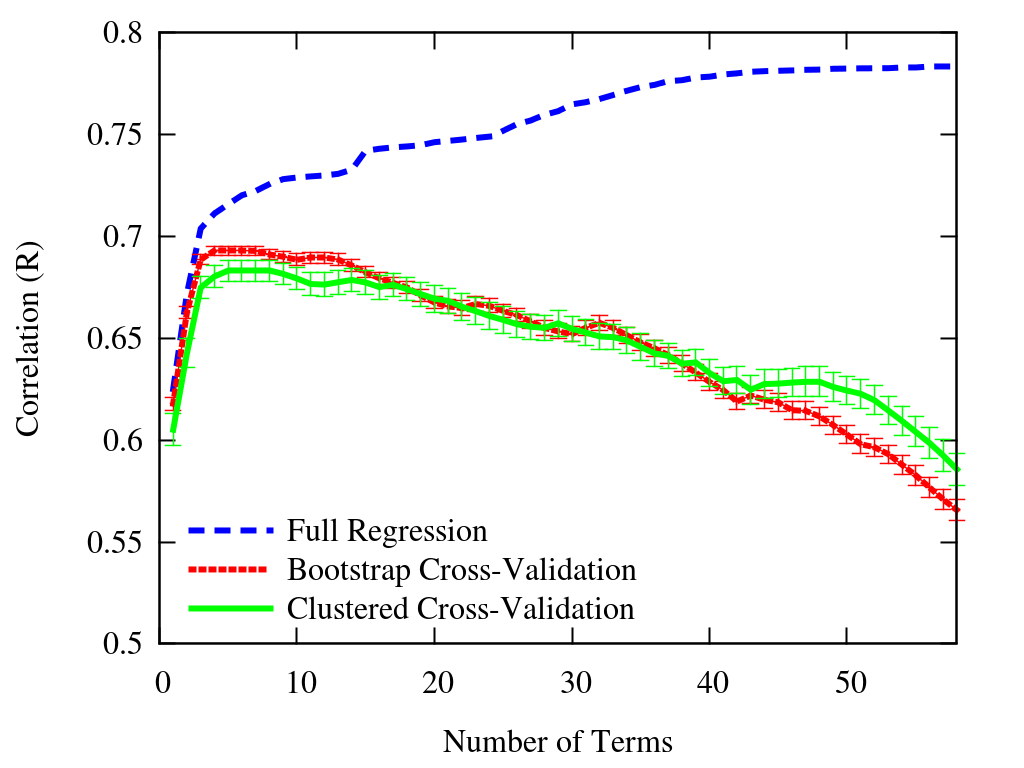 Forward feature selection:
Forward feature selection:- Start with no features
- For every remaining feature
- Train and evaluate model with current feature set plus one remaining feature
- Add best performing feature to feature set
- Repeat
- Backward feature selection: Same as forward only in reverse (start with all features selected).
%%html
<div id="featuresel2" style="width: 500px"></div>
<script>
$('head').append('<link rel="stylesheet" href="https://bits.csb.pitt.edu/asker.js/themes/asker.default.css" />');
var divid = '#featuresel2';
jQuery(divid).asker({
id: divid,
question: "Which is usually faster?",
answers: ["Forward feature selection","Backward feature selection","They are about the same"],
server: "https://bits.csb.pitt.edu/asker.js/example/asker.cgi",
charter: chartmaker})
$(".jp-InputArea .o:contains(html)").closest('.jp-InputArea').hide();
</script>
%%html
<div id="featuresel3" style="width: 500px"></div>
<script>
$('head').append('<link rel="stylesheet" href="https://bits.csb.pitt.edu/asker.js/themes/asker.default.css" />');
var divid = '#featuresel3';
jQuery(divid).asker({
id: divid,
question: "Forward and backwards feature selection will select the same features if run to completion.",
answers: ["True","False"],
server: "https://bits.csb.pitt.edu/asker.js/example/asker.cgi",
charter: chartmaker})
$(".jp-InputArea .o:contains(html)").closest('.jp-InputArea').hide();
</script>
Non-greedy algorithms¶
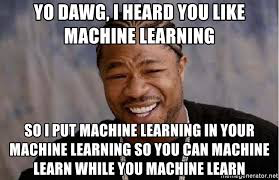 Randomly select features
Randomly select features- genetic algorithm for selecting features
- more intelligent search strategies (with backtracking)
- ...
Key Points¶
- Must cross-validate or otherwise evaluate model on unseen data
- your validation should accurately represent the intended use of the model
- Need to parameterize model
- feature representation (representation)
- feature selection
- regularization
- model-specific settings
- Once parameterized, train on full dataset
- Ideally, retain independent test set that is not used for model optimization as final estimate of generalization error
- Relationship of test set to training set should mimic expected relationship of new data to existing data.
Some simple classifiers¶
Naive Bayes¶
Make the simplistic assumption that all our features are independent and apply Bayes' theorem.
$$P(y \mid x_1,\dots,x_n) = \frac{P(y)P(x_1,\dots,x_n \mid y)}{P(x_1,\dots,x_n)}$$ If $x_i$ are independent $$P(x_i \mid y, x_1,\dots,x_{i-1},x_{i+1}, \dots,x_n) = P(x_i \mid y)$$ and therefore (by the chain rule) $$P(y \mid x_1,\dots,x_n) \propto P(y) \prod_i^n P(x_i \mid y)$$
$P(y)$ is the probability of seeing class $y$. E.g., count the number of true examples and divide by the total number of training exampels to get $P(y=true)$.
Naive Bayes¶
The various versions of naive Bayes primarily differ in how $P(x_i \mid y)$ is estimated and whether $x_i$ is Boolean or a count.
Multinomial Naive Bayes¶
Multinomial only cares about the presence of features and can handle feature counts.
$$P(x_i \mid y ) = \frac{N_{yi} + \alpha}{N_y + n\alpha}$$
$N_{yi}$ is the number of times $x_i$ occurs in class $y$ in the training set.
$N_y$ is the total number of all features in the class. $\sum_iN_{yi}$
$\alpha$ is a smoothing parameter
$n$ is the number of features
Bernoulli Naive Bayes¶
Bernoulli requires binary features and considers both the presence and absence of features.
$$P(x_i \mid y ) = p_{yi}x_i+(1-p_{yi})(1-x_i)$$ where $$p_{yi} = \frac{N_{yi}}{|y|}$$ We can include a smoothing parameter $\alpha$ here as well.
%%html
<div id="smoothing" style="width: 500px"></div>
<script>
$('head').append('<link rel="stylesheet" href="https://bits.csb.pitt.edu/asker.js/themes/asker.default.css" />');
var divid = '#smoothing';
jQuery(divid).asker({
id: divid,
question: "Which value of alpha would cause problems if we encounter a feature not in the training set?",
answers: ["0","0.5","1","2"],
server: "https://bits.csb.pitt.edu/asker.js/example/asker.cgi",
charter: chartmaker})
$(".jp-InputArea .o:contains(html)").closest('.jp-InputArea').hide();
</script>
Applying Naive Bayes¶
from sklearn.naive_bayes import MultinomialNB
from sklearn.naive_bayes import BernoulliNB
multinb = MultinomialNB()
Bnb = BernoulliNB()
multinb,Bnb
(MultinomialNB(), BernoulliNB())
Multinomial w/smoothing (test-on-train)¶
from sklearn.metrics import roc_auc_score
multinb.fit(features,data.alive)
roc_auc_score(data.alive,multinb.predict(features))
0.7198366495785906
Bernoulli w/smoothing (test-on-train)¶
Bnb.fit(features,data.alive)
roc_auc_score(data.alive,Bnb.predict(features))
0.6330263272221739
Bernoulli no smoothing (test-on-train)¶
Bnb = BernoulliNB(alpha=0,force_alpha=True)
Bnb.fit(features,data.alive)
roc_auc_score(data.alive,Bnb.predict(features))
/Users/dkoes/Library/Python/3.9/lib/python/site-packages/sklearn/naive_bayes.py:1214: RuntimeWarning: divide by zero encountered in log self.feature_log_prob_ = np.log(smoothed_fc) - np.log( /Users/dkoes/Library/Python/3.9/lib/python/site-packages/sklearn/utils/extmath.py:189: RuntimeWarning: invalid value encountered in matmul ret = a @ b
0.5
Implementing Naive Bayes¶
#snippet from sklearn - Y has been binarized
n_effective_classes = Y.shape[1]
self.class_count_ = np.zeros(n_effective_classes, dtype=np.float64)
self.feature_count_ = np.zeros((n_effective_classes, n_features),
dtype=np.float64)
self._count(X, Y)
alpha = self._check_alpha()
self._update_feature_log_prob(alpha)
self._update_class_log_prior(class_prior=class_prior)
Bernoulli¶
def _count(self, X, Y):
"""Count and smooth feature occurrences."""
if self.binarize is not None:
X = binarize(X, threshold=self.binarize)
self.feature_count_ += safe_sparse_dot(Y.T, X)
self.class_count_ += Y.sum(axis=0)
def _update_feature_log_prob(self, alpha):
"""Apply smoothing to raw counts and recompute log probabilities"""
smoothed_fc = self.feature_count_ + alpha
smoothed_cc = self.class_count_ + alpha * 2
self.feature_log_prob_ = (np.log(smoothed_fc) -
np.log(smoothed_cc.reshape(-1, 1)))
With feature_log_prob_ calculated, prediction is straightforward:
def _joint_log_likelihood(self, X):
#... checking ...
return (safe_sparse_dot(X, self.feature_log_prob_.T) +
self.class_log_prior_)
def predict(self, X):
jll = self._joint_log_likelihood(X)
return self.classes_[np.argmax(jll, axis=1)]
def predict_log_proba(self, X):
jll = self._joint_log_likelihood(X)
# normalize by P(x) = P(f_1, ..., f_n)
log_prob_x = logsumexp(jll, axis=1)
return jll - np.atleast_2d(log_prob_x).T
How can we make Naive Bayes scale?
help(Bnb.partial_fit)
Help on method partial_fit in module sklearn.naive_bayes:
partial_fit(X, y, classes=None, sample_weight=None) method of sklearn.naive_bayes.BernoulliNB instance
Incremental fit on a batch of samples.
This method is expected to be called several times consecutively
on different chunks of a dataset so as to implement out-of-core
or online learning.
This is especially useful when the whole dataset is too big to fit in
memory at once.
This method has some performance overhead hence it is better to call
partial_fit on chunks of data that are as large as possible
(as long as fitting in the memory budget) to hide the overhead.
Parameters
----------
X : {array-like, sparse matrix} of shape (n_samples, n_features)
Training vectors, where `n_samples` is the number of samples and
`n_features` is the number of features.
y : array-like of shape (n_samples,)
Target values.
classes : array-like of shape (n_classes,), default=None
List of all the classes that can possibly appear in the y vector.
Must be provided at the first call to partial_fit, can be omitted
in subsequent calls.
sample_weight : array-like of shape (n_samples,), default=None
Weights applied to individual samples (1. for unweighted).
Returns
-------
self : object
Returns the instance itself.
k-NN¶
$k$ nearest neighbors is a non-generalizing classifier.
To make a prediction it finds the $k$ "nearest" examples in the training set and
- takes the majority vote (classification) or
- takes the average value (regression)
- can weight votes/values by distance to give higher priority to closer data points
k-nn literally memorizes the training set.
Since we want a generalizing classifier and k-nn, by construction, is not, k-nn is often used as baseline for comparison.
Particularly for "big data", k-NN usually isn't a practical algorithm for prediction. Why?
k-NN Classification¶

import numpy as np
import matplotlib.pyplot as plt
from matplotlib.colors import ListedColormap
from sklearn import neighbors, datasets
def showknn():
n_neighbors = 15
# import some data to play with
iris = datasets.load_iris()
# we only take the first two features. We could avoid this ugly
# slicing by using a two-dim dataset
X = iris.data[:, :2]
y = iris.target
h = .02 # step size in the mesh
# Create color maps
cmap_light = ListedColormap(['#FFAAAA', '#AAFFAA', '#AAAAFF'])
cmap_bold = ListedColormap(['#FF0000', '#00FF00', '#0000FF'])
weights = 'uniform'
ks = [1,3,5,10,15,50,100,150]
plt.figure(figsize=(len(ks)*4,12))
for (i,n_neighbors) in enumerate(ks):
# we create an instance of Neighbours Classifier and fit the data.
clf = neighbors.KNeighborsClassifier(n_neighbors, weights=weights)
clf.fit(X, y)
# Plot the decision boundary. For that, we will assign a color to each
# point in the mesh [x_min, x_max]x[y_min, y_max].
x_min, x_max = X[:, 0].min() - 1, X[:, 0].max() + 1
y_min, y_max = X[:, 1].min() - 1, X[:, 1].max() + 1
xx, yy = np.meshgrid(np.arange(x_min, x_max, h),
np.arange(y_min, y_max, h))
Z = clf.predict(np.c_[xx.ravel(), yy.ravel()])
# Put the result into a color plot
Z = Z.reshape(xx.shape)
plt.subplot(2,len(ks)//2,i+1)
plt.pcolormesh(xx, yy, Z, cmap=cmap_light,shading='nearest')
# Plot also the training points
plt.scatter(X[:, 0], X[:, 1], c=y, cmap=cmap_bold,
edgecolor='k', s=20)
plt.xlim(xx.min(), xx.max())
plt.ylim(yy.min(), yy.max())
plt.title("3-Class classification (k = %i, weights = '%s')"
% (n_neighbors, weights))
plt.show()
showknn()
from sklearn.neighbors import KNeighborsClassifier
from sklearn.metrics import roc_curve
knn = KNeighborsClassifier(n_neighbors=5)
knn.fit(features,data.alive)
pred = knn.predict_proba(features)
fpr,tpr,_ = roc_curve(data.alive,pred[:,1])
fpr = np.insert(fpr,0,0);tpr = np.insert(tpr,0,0)
plt.plot(fpr,tpr,linewidth=3)
plt.gca().set_aspect('equal');plt.ylim(0,1);plt.xlabel('FPR');plt.ylabel('TPR');
Why does the ROC curve look like this?
k-NN Regression¶
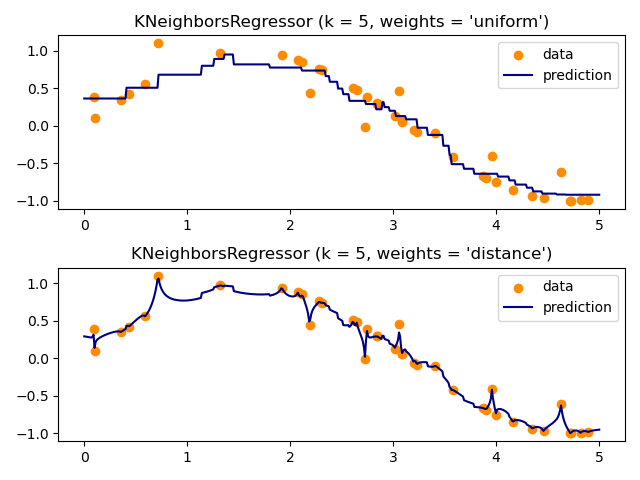
An Example¶
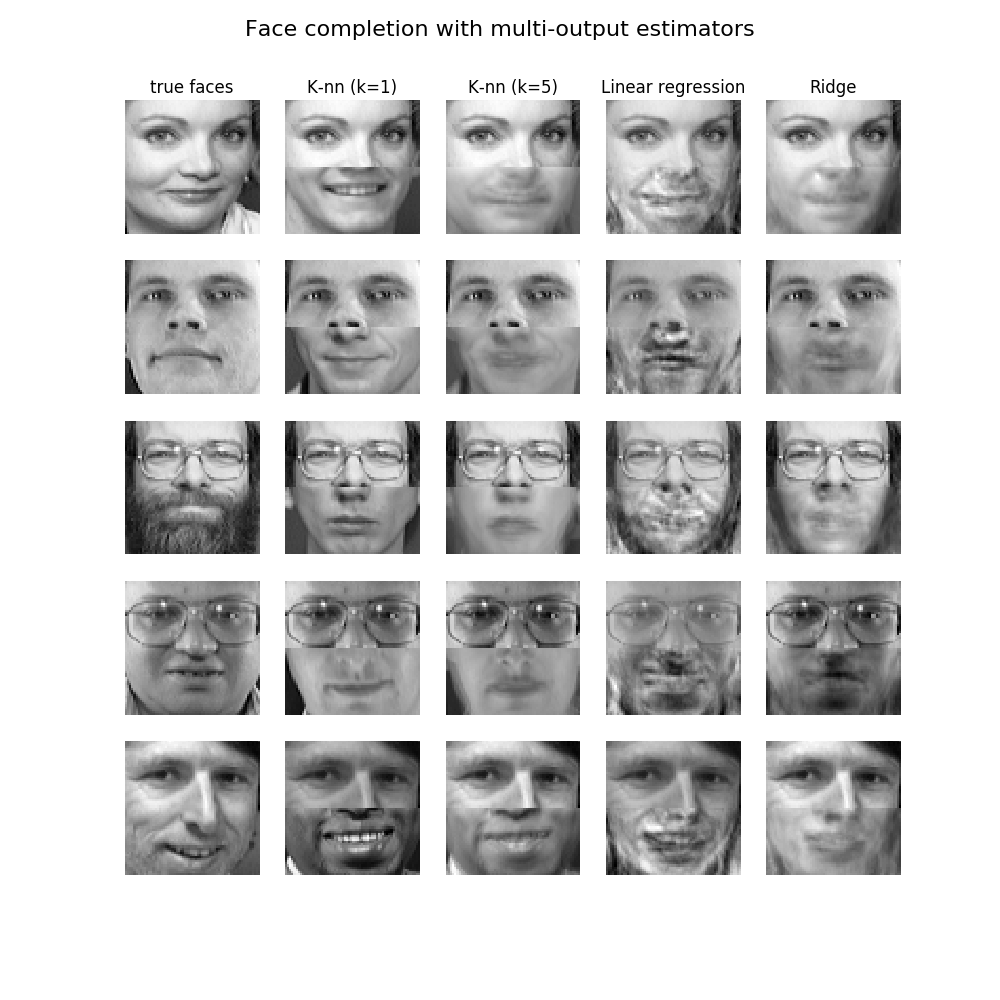
How would you scale k-NN?
Next Week¶
- Matrix factorization
- Intro to computer systems